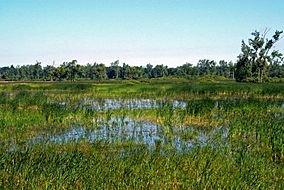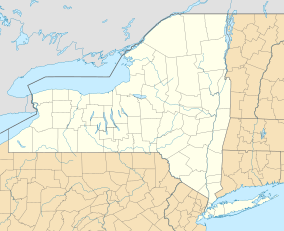Iroquois National Wildlife Refuge facts for kids
Quick facts for kids Iroquois National Wildlife Refuge |
|
|---|---|
|
IUCN Category IV (Habitat/Species Management Area)
|
|
 |
|
| Location | Genesee and Orleans counties, New York, United States |
| Nearest city | Batavia, New York |
| Area | 10,828 acres (43.82 km2) |
| Established | May 19, 1958 |
| Governing body | U.S. Fish and Wildlife Service |
| Website | Iroquois National Wildlife Refuge |
The Iroquois National Wildlife Refuge is a special place in western New York where wild animals are protected. It's found between the cities of Buffalo and Rochester. The United States Fish and Wildlife Service takes care of this important area.
You can find the main office and visitor center in Alabama, New York. Part of the refuge is also in Shelby.
Contents
Amazing Animals at the Refuge
What animals can you find here? Lots! You might spot a white-tailed deer or a busy squirrel. Look out for a porcupine or a muskrat near the water.
Other cool animals living here include raccoons and coyotes. You might also see a skunk or a hardworking beaver. Tiny chipmunks scamper around, and river otters play in the water. There are also two types of fox, bobcats, mink, opossum, and woodchucks.
History of the Refuge
The refuge started in 1958. It was first called the Oak Orchard National Wildlife Refuge. But its name was changed soon after. This was to avoid confusion with another nearby area. That area was the Oak Orchard Wildlife Management Area.
Both the refuge and the Oak Orchard Wildlife Management Area are important. They help migratory birds and other animals. They are part of a bigger area called the Alabama Swamp Complex. This complex also includes the Tonawanda Wildlife Management Area.
The U.S. Fish and Wildlife Service manages the Iroquois National Wildlife Refuge. The New York State Department of Environmental Conservation manages the other two areas.
What You Can See and Do
The refuge is huge, covering about 10,828 acres (43.8 square kilometers). It has many different habitats. You'll find large pools of water, swamps, meadows, fields, and woodlands.
There are four special spots to view wildlife. There are also four trails you can use all year. Most areas of the refuge are closed from March 1 to October 1. This helps protect nesting birds and other wildlife. The refuge is a key resting spot for birds during their migration. Because of this, it's called an Important Bird Area (IBA).
Exploring the Refuge's Layout
The western part of the refuge has four big wetlands. They are called Cayuga Pool, Mohawk Pool, Oneida Pool, and Seneca Pool. The Feeder Road separates some of these pools.
Cayuga Pool has a viewing platform where you can watch animals. The Kanyoo Trail is nearby and has two loops. One loop is 0.33 miles long, and the other is 1 mile long. The Feeder Road is 3.5 miles long (one way) and is open for walking all year.
The eastern part of the refuge has smaller pools and many marshy areas. It also has fields and forests. The Swallow Hollow Trail is a 1.3-mile loop. It goes around the Swallow Hollow Marsh. The Onondaga Trail is 1.2 miles long (one way). It passes along the north side of Onondaga Pool and through an old forest.
Geography of the Refuge
The wetlands in the refuge get their water from Oak Orchard Creek.
New York State Route 63 is a main road that goes right through the middle of the refuge.
Public Activities and Rules
You can enjoy many activities at Iroquois National Wildlife Refuge. These include hiking, cross-country skiing, and snowshoeing. It's also a great place for watching nature and taking photos.
You can use non-motorized boats on Oak Orchard Creek. Bicycles are allowed only on public roads inside the refuge. If you have the right permits, you can also hunt, fish, and trap during certain seasons.
Some things are not allowed to keep the refuge safe and healthy. You cannot camp, disturb old artifacts, or swim. Fires are not allowed, and you cannot remove wildlife or plants. Horseback riding and off-road vehicles are also not permitted. You can only carry firearms during hunting season with a permit.
The Iroquois Job Corps is also located within the refuge.



